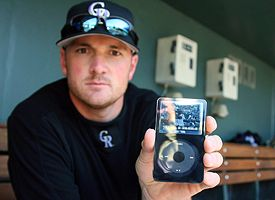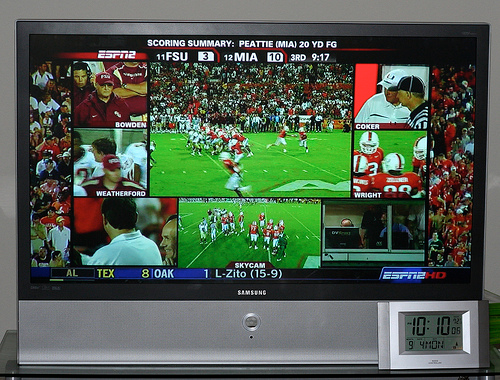ESPN’s “Full Circle” and Media Convergence
by: Harper Cossar / Georgia State University

IN ADDITION TO OUR REGULAR COLUMNISTS AND GUEST COLUMNS, FLOW IS ALSO COMMITTED TO PUBLISHING TIMELY FEATURE COLUMNS, SUCH AS THE ONE BELOW. THE EDITORS OF FLOW REGULARLY ACCEPT SUBMISSIONS FOR THIS SECTION. PLEASE VISIT OUR “CALLS” PAGE FOR CONTACT INFORMATION.
What is “shown” on television is always the result of a complex process of selection: what items to report, what to leave out, what to replay, and what to downplay. Television sports production also involves a wide range of processes of visual and narrative representation–choices regarding the images, language, camera positioning, and story line required to translate “what happened” into a program that makes “good television.”
— Richard Gruneau (“Making Spectacle” 134-35)
To suggest that ESPN's “Full Circle” programming is the very definition of media convergence (and transtextuality) is an understatement. Four times this year ESPN has utilized its expansive (Disney-owned) family of networks to show a single sporting event in as many as nine different media manifestations. These include “traditional” network telecasts on ESPN (and ESPN-HD), ESPN2 (and ESPN2-HD), ESPNU and ESPN International, in addition to broadband coverage on ESPN.com, ESPN360 (subscription online service) and Mobile ESPN (phone service by AT&T). What's so interesting about a sports network exploiting sports-crazed media junkies? Sure, it's compelling that ESPN is using its network “family” to reap advertising money by selling ad space to the same event nine times, but what is really innovative is the broadcast implications of the multi-screen interface on ESPN2 (and ESPN2-HD).
While ESPN (and ESPN-HD) offer a “traditional game telecast,” ESPN2's coverage is something akin to the multi-image mosaics of films such as The Boston Strangler (1968) or Time Code (2000). Certainly, prime-time TV is no stranger to multi-screening, but typically 24's uses of such techniques serve as exposition or transitional strategies. ESPN's deployment of the multi-screening visuals is interesting not only for its narrative uses, but for its subject matter: sporting events have a particular fascination of and dependency upon visual style and editing practices.

In the modern media era, sports utilize film and video in ways that few other industries can claim. Players and coaches regularly have “film sessions” to study opposing teams' defensive strategies and schemes. Golfers watch high-speed video of their swings to work out minute flaws, and baseball players use video iPods to study opposing pitchers' tendencies. Many university (and virtually all professional) sports programs house editing suites with teams of editors whose sole purpose is to edit highlight packages for game “prep” by the assistant coaches. In this way, coaches study film (actually video) with the same passion that we media scholars analyze texts but for different goals. Coaches look for small quirks of opposing squads to exploit them and thus gain an edge.
Games are often “decided” by “instant replay” (the use of video to review and revise the on-field rulings of the officials) that undermines the inherent liveness and spontaneity of the sporting events. After all, many fans will proclaim that the very unpredictability of sporting events–who will win and how–is their largest and most important reason for watching. Therefore, ESPN decided to up the ante of what is considering lingua franca in sports broadcasting–coverage.
Like DVD commentaries and multiple-angle options, ESPN decided to not preference any one vantage point in a single broadcast to show the action on the field. Instead, ESPN's Full Circle on ESPN2 shows what it feels like to attend the event itself but still have a multitude of information about the game and its participants. The mosaic view mimics a producer's bank of separate video feeds to switch between and provides dedicated camera coverage of coaches on the sidelines, quarterbacks on the field and off, a skycam view1 (integrated from the video game franchises of EA Sports), fans in the stands and in-studio commentary. This last feature is particularly problematic for aural clarity. The in-studio commentators are in a lower quadrant of the screen and much like in Time Code, their vocal tracks are overlapped with the in-game commentary. The resulting cacophony of sound and visual spectacle is novel, but very authentically mimics the confusion and excitement of a live sporting event.

While certain TV techniques like letterboxing can corral a viewer's gaze and represent authorial control by the producers, ESPN's decision to splinter the screen into a jigsaw puzzle requires even more manipulation to guide viewers' eyeballs. Why would a network willingly deploy a technique that almost certainly will confuse and frustrate its viewers? ESPN observes the guiding rule of sports broadcasting for fans: the only thing better than coverage of “their” game is more coverage. ESPN's goal for the Full Circle programming package is deluge. Sports fans and commentators often interact via the vocabulary of statistics (or “stats”): How many fouls does a player have? How many seconds remaining on the shot/play clock? What is the passing completion percentage for a certain quarterback? ESPN distributes all of this information throughout the mosaic telecast either at the top center of the frame (see above image) or alternately with “bleeds” via a vertical stats box down the left edge of the frame. This last technique exploits and emphasizes the wider (16:9) HD proportions, further fetishizing the technological prowess of both the network and the viewer.
What then are we to make of ESPN's decision de deluge? Is this the direction that sports broadcasting will go to compete with new media environments such as video games and/or DIY consumer-created texts that appear on YouTube? This is unlikely in the immediate future, but ESPN has established that the “full screen” approach to covering sports is not indispensable. Will this mosaic view become a norm of TV visual style? We are all accustomed to viewing (and listening to) multiple talking heads vivified in split-screen fashion on any number of news programs, so one can't say that ESPN is revolutionizing TV watching with Full Circle. ESPN's decision to exploit and fully utilize its empirical powers to sell one telecast in as many formats as possible and therefore to secure as much ad revenue as possible is probably the most compelling industrial aspect of this innovative move. As ESPN continues to experiment with its broad-reaching network of media outlets, we can be certain that more unique ways to cover sporting events will follow, and for us sports fans that is a good thing.
Works Cited
Bolter, Jay David and Richard Grusin. Remediation: Understanding New Media. Cambridge: MIT P, 2002.
Garfield, Bob. “Innovation Boxes out Effective Approach in Mercedes-Benz Ads.” Advertising Age 63.19 (1992): 77.
Gruneau, Richard. “Making Spectacle: A Case Study in Television Sports Production.” Media, Sports and Society. Ed. Lawrence A. Wenner. London: Sage, 1989. 134+.
Kendrick, James. “Aspect Ratios and Joe Six-Packs: Home Theater Enthusiasts Battle to Legitimize the DVD Experience.” Velvet Light Trap 56 (2005): 58-70.
King, Geoff, and Tanya Kryzwinska. Screenplay: Cinema/videogames/interfaces. New York: Wallflower, 2002.
Manovich, Lev. The Language of New Media. Cambridge: MIT P, 2001.
Vagoni, Anthony. “Out of the Box.” Advertising Age 70.46 (1999): 48-50.
Note
1 For ESPN's Full Circle coverage of basketball games, this camera is replaced with a dedicated camera “above the rim.”
Image Credits:
1. Logo from 2006 NBA Playoffs
2. Jason Jennings scouting opposing batters
3. FSU vs. Miami on Full Circle
Please feel free to comment.
A thought on remediation
Interesting comments about sports presentation in some of its current outlets and formats. It seems to me that a productive conversation could be started across genres in terms of entertainment and remediation in the contemporary landscape. I am particularly thinking of the comic genre’s increased proliferation across outlets, as well as the layout of shows, including Full Circle (sports) and dare I bring in CSI (crime procedure), that have started to employ a comic book aesthetic/design to genres not obviously linked to comics.
down to the nitty gritty
As a sports fan and a communications student, this article caught my eye for a multitude of reasons. First, this form of sensory overload from ESPN serves as an extreme form of narrowcasting to a niche audience of intense sports fans. Of course, many (most in my opinion) people will not be interested in viewing a game “360,” therefore this style appeals to a particular group of fans who can never get enough coverage. What I noticed about this broadcasting style as well is the new amount of textual freedom it allows the viewer. Instead of our attention being directed where the producers want it to be, ESPN allows us to choose (based on a limited number of selections) which angle of the game to follow. This no doubt has the potential to engage the reader beyond the simple telecast itself. I thought that the profit motive pointed out by Cossar was an on-point observation as to the real reason ESPN employs such tactics. The fact is, however, there is a niche of people out there who relish in this coverage, ensuring advertising dollars will keep coming.
Too Many Choices
I consider myself a pretty die-hard fan when it comes to college football and even this idea of “extreme” coverage and dozens of video feeds of angles of the game I hadn’t even thought of is honestly kind of nauseating. In some ways I agree that ESPN is doing it to appeal to even more audiences and those die-hard fans, kind of like myself, but one cannot also ignore the fact that this is also a huge profit for them, like the article explains. Not only does this new delivery on ESPN2:Full Circle cost money, but these games are broadcast on dozens of ESPN-owned medias simultaneously(ESPN, ESPN Radio, etc.), each with their own separate advertisements which go to ESPN. This blatant attempt to get even more amounts of money is just too strong to ignore, especially the multiple camera angle presentation on ESPN2:Full Circle. It’s not that I don’t like the idea of being able to choose what I can see, it’s just that I don’t want to miss something really crucial. I feel much more comfortable letting the professionals show me what’s important because it’s what they get paid to do; I don’t want to have to pay to do what they get paid to do. In the end, this new presentation is creating an alternative media causing niche audiences to form and begin devoting their time and money to this brand new media that is a little overboard.
Once upon a time, ESPN was my favorite channel. It was an early morning refuge when Sportscenter was in it’s heyday. Come primetime, it was my destination for college hoops, or the aptly named NFL highlight show, NFL Primetime. Now ESPN has gotten too big for it’s own good; Sportscenter is antiquated and redundant and NFL Primetime is deceased. ESPN Full Circle is just another example of ESPN trying to make themselves bigger than the event. For this game, the actual game seemed almost secondary to the “event” of ESPN going full circle. ESPN makes news events out of the fact that they are ESPN and they feel it’s important that they add their little spin to any game. It seems like ESPN doesn’t trust the fan anymore so they need to do crap like Full Circle to make a spectacle out of a college football game that really just needs regular coverage and competent announcers. Plus it gave a me a freaking headache, now I know what it looks like for a fruit-fly to watch ACC football.
What I think is missing in this article though is the point of view of ESPN itself. There had to be a reason for them to make this change to their “full circle” coverage which the article describes as too much for its own good. While certainly aiming for more ad-revenue by showing the sports event on several of its many networks, ESPN is also trying to do something innovative to keep up with a new breed of viewer. Television viewers today want everything, including their sports news delivered to them immediately. There is also a fast change to high definition coverage in sports, which ESPN is leading the charge, as well as desire for online content, which they offer to their viewers as well. The rise of the internet and desire of consumers for everything in their lives to be “on-demand” has brought this upon ESPN. This new style of “full-circle” coverage also makes the viewer feel in control, granting them the freedom to view many aspects of a particular sports game in ways that were not possible to them before. While it may or may not end up being successful is yet to be seen, but it is an innovative way of the network to provide something new for its viewers.
Thanks a lot for this thing here.